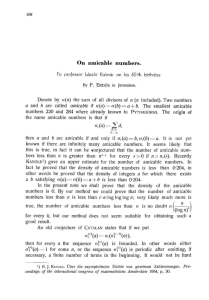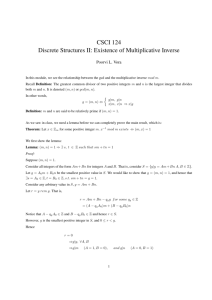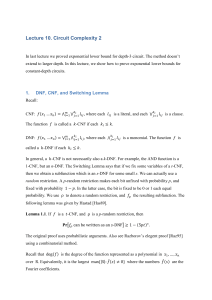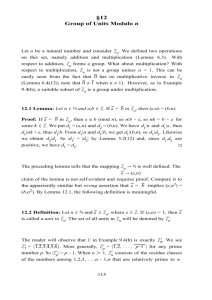EQUIDISTRIBUTION IN THE d
advertisement
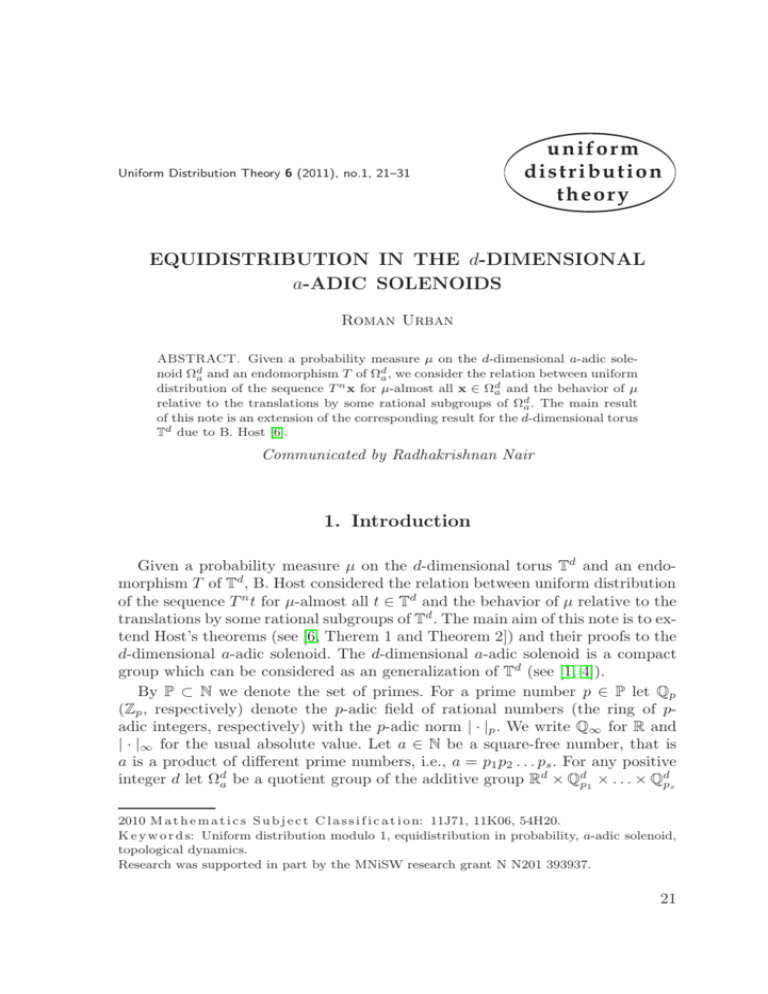
Uniform Distribution Theory 6 (2011), no.1, 21–31
uniform
distribution
theory
EQUIDISTRIBUTION IN THE d-DIMENSIONAL
a-ADIC SOLENOIDS
Roman Urban
ABSTRACT. Given a probability measure µ on the d-dimensional a-adic solenoid Ωda and an endomorphism T of Ωda , we consider the relation between uniform
distribution of the sequence T n x for µ-almost all x ∈ Ωda and the behavior of µ
relative to the translations by some rational subgroups of Ωda . The main result
of this note is an extension of the corresponding result for the d-dimensional torus
Td due to B. Host [6].
Communicated by Radhakrishnan Nair
1. Introduction
Given a probability measure µ on the d-dimensional torus Td and an endomorphism T of Td , B. Host considered the relation between uniform distribution
of the sequence T n t for µ-almost all t ∈ Td and the behavior of µ relative to the
translations by some rational subgroups of Td . The main aim of this note is to extend Host’s theorems (see [6, Therem 1 and Theorem 2]) and their proofs to the
d-dimensional a-adic solenoid. The d-dimensional a-adic solenoid is a compact
group which can be considered as an generalization of Td (see [1, 4]).
By P ⊂ N we denote the set of primes. For a prime number p ∈ P let Qp
(Zp , respectively) denote the p-adic field of rational numbers (the ring of padic integers, respectively) with the p-adic norm | · |p . We write Q∞ for R and
| · |∞ for the usual absolute value. Let a ∈ N be a square-free number, that is
a is a product of different prime numbers, i.e., a = p1 p2 . . . ps . For any positive
integer d let Ωda be a quotient group of the additive group Rd × Qdp1 × . . . × Qdps
2010 M a t h e m a t i c s S u b j e c t C l a s s i f i c a t i o n: 11J71, 11K06, 54H20.
K e y w o r d s: Uniform distribution modulo 1, equidistribution in probability, a-adic solenoid,
topological dynamics.
Research was supported in part by the MNiSW research grant N N201 393937.
21
ROMAN URBAN
by a discrete subgroup
o
n
B d = (b, −b, . . . , −b) : b ∈ Z[1/a]d ,
where Z[1/a] is the ring obtained from Z by adjoining 1/a. Thus,
.
Ωda = Rd × Qdp1 × · · · × Qdps B d.
The quotient group Ωda is a compact Abelian group called the d-dimensional
a-adic solenoid (see [4]).
The ring End(Ωda ) of continuous endomorphisms of Ωda is isomorphic
to M(d, Z[1/a]), where M(d, R) denotes the ringQof d × d matrices over a ring R.
s
The action of the matrix C ∈ M(d, Z[1/a]) on j=0 Qdpj is given by
C(x0 , x1 , . . . , xs ) = (Cx0 , Cx1 , . . . , Cxs ),
Qs
(x0 , x1 , . . . , xs ) ∈ j=0 Qdpj , and the vectors xk ∈ Qdpk , k = 0, . . . , s, are considered as column vectors.
If C is an endomorphism of Ωda , then the dual endomorphism Ĉ is given
by the same matrix acting from the right on Z[1/a]d .
Let T ∈ M(d, Z[1/a]). According to [5, 6], we say that the sequence T n x,
x ∈ Ωda is equidistributed in probability for the measure µ if, for every weak-∗
neighborhood U of the Lebesgue measure,
(
)
N
−1
X
1
lim µ x ∈ Ωda :
δT n x 6∈ U = 0.
N →∞
N n=0
For integer q > 1, define the following subgroup Dq of Ωda ,
jd −j1
−jd
−j1
−jd
j1
, . . . , n , n , . . . , n , . . . , n , . . . , n + Bd :
Dq =
qn
q
q
q
q
q
0 ≤ j1 , . . . , jd ≤ q n, n ≥ 1 . (1.1)
Let
Dq,k =
j1
jd −j1
−jd
−j1
−jd
,..., k, k ,..., k ,..., k ,..., k
k
q
q
q
q
q
q
+ Bd :
0 ≤ j1 , . . . , jd ≤ q
Then
Dq =
[
k≥1
22
Dq,k .
k
. (1.2)
EQUIDISTRIBUTION IN SOLENOIDS
Define the following measures
ωk =
X
δx ∗ µ.
x∈Dq,k
Let
ϕk (x) =
dµ(x)
dωk (x)
(1.3)
be the Radon-Nikodym derivative.
We say that the probability measure µ on Ωda is Dq -conservative if for every
Borel set E with µ(E) > 0, there exists y ∈ Dq , y 6= 0, with µ(E ∩ (y + E)) > 0.
We say that µ is Dq -conservative with exponential decay if
1
lim inf − log ϕk (x) > 0,
k→∞
k
µ-a.e.
The main result of this note is the following.
1.4. Let T∈ M(d, Z[1/a]), where a = p1 p2 . . . ps is a product of differαm
ent primes. Let Dq be the subgroup of Ωda , defined in (1.1), with q = q1α1. . . qm
> 1,
where qi ∈ P, αi ≥ 1.
Assume that
Theorem
(i) for every integer r > 1 the characteristic polynomial of T r is irreducible
over Q,
(ii) for j = 1, . . . , s, |q|pj = 1,
(iii) for j = 1, . . . , m, | det T |qj = 1.
Then
(1) if the probability measure µ on Ωda is Dq -conservative, then the sequence
T n x is equidistributed in probability for µ;
(2) if the probability measure µ on Ωda is Dq -conservative, with exponential
decay then for µ-a.e. x ∈ Ωda the sequence T n x is equidistributed.
Remark.
Condition (i) implies that det T 6= 0, that is T ∈ GL(d, R).
It should be emphasized that when an appropriate formulation, given
in Theorem 1.4 above, of the extension of Host’s results [6, Theorem 1 and Theorem 2] is found then the proof is relatively easy. It amounts to some modifications
of the original proofs which are necessary in the new more general setting.
Remark.
23
ROMAN URBAN
2. Lemmas
For a given positive integer q we denote by Ωda (q) the subgroup of Ωda consisting
of all elements whose order divides q.
Lemma
2.1. For every q ∈ N, the subgroup
is finite.
d
Ωda (q) ≃ Z[1/a]d /qZ[1/a]d ≃ Z[1/a]/qZ[1/a]
P r o o f. (See [1] Lemma II.13) It is enough to show that Z[1/a]d /qZ[1/a]d is a
finite group. Let γ1 , . . . , γc ∈ Z[1/a]d be different elements of Z[1/a]d /qZ[1/a]d .
Consider for n = 0, 1, 2, . . . the following subgroups
1
Gn = Z[1/a]d ∩ Zd of Z[1/a]d .
n!
1 d
Clearly, Gn is a rank d subgroup of n!
Z and so Gn ≃ Zd . Since Gn ⊂ Gn+1
S∞
d
and n=0 Gn = Ωa , there exists k ∈ N such that for every 1 ≤ i ≤ c, we have
γi ∈ Gk . The elements γ1 , . . . , γc belong to different classes modulo qGk . Since
Zd /qZd has order q d we get c ≤ q d .
It was pointed out by the referee that there is a simple formula for the
cardinality c of the group Z[1/a]d /qZ[1/a]d . More specifically, the cardinality of
Z[1/a]d /qZ[1/a]d is the number of points fixed by the endomorphism x 7→ (1−q)x
on Z[1/a]d. There is a well-known formula for the cardinality of the later set,
given for example in [2, Lemma 5.2], from which it follows that
d
Y
|q|p ≤ q d .
c = |q|∞
Remark.
p|a
This formula can be view via an adelic covering lemma that makes this just
a volume calculation in some finite product of p-adic fields (see [2]).
Let a be a product of different prime numbers a = p1 p2 . . . ps , pj ∈ P, and let
T = (tij ) ∈ M(d, Z[1/a]) ∩ GL(d, R). Set
r = 2 + d(d − 1)/2,
and consider, for an integer q satisfying (ii) of Theorem 1.4, the matrix
T̃ ∈ M d, Z[1/a]/q r Z[1/a] ,
with entries
t̃ij = tij mod q r Z[1/a] = tij + q r Z[1/a].
24
(2.2)
EQUIDISTRIBUTION IN SOLENOIDS
αm
2.3. Let T ∈ M(d, Z[1/a]) ∩ GL(d, R), r ≥ 1. Let q = q1α1 q2α2 . . . qm
,
qi ∈ P, αi ∈ N. Assume that for 1 ≤ i ≤ m, | det T |qi = 1. Then there exists a
number τ ∈ N such that
Lemma
T τ ≡ Id mod q r Z[1/a]d ,
where Id stands for the identity d × d-matrix.
P r o o f. By Lemma 2.1 the matrix T̃ acts naturally on the finite module
d
Z[1/a]/q r Z[1/a]
over the finite ring Z[1/a]/q r Z[1/a].
d
Thus we have an action of the semigroup N on Z[1/a]/q r Z[1/a] , given by
d
k.x = T k x, k ∈ N, x ∈ Z[1/a]/q r Z[1/a] . Since | det T |qi = 1, for 1 ≤ i ≤ m,
we conclude that det T̃ is invertible in Z[1/a]/q r Z[1/a], hence
T̃ ∈ GL d, Z[1/a]/q r Z[1/a] .
Thus {T̃ k : k ∈ N} is a semigroup contained in the finite group
GL d, Z[1/a]/q r Z[1/a] ;
it follows that {T̃ k : k ∈ N} is a group. Thus there exists a τ such that T̃ τ = Id ,
and the lemma is proved.
Denote
I(N ) = {0, 1, . . . , N − 1}d .
Let us fix some ε ∈ (0, 1), and let α be an integer so large that the set
Λ = n ∈ Nd : ni 6= nj mod pα for all i 6= j and all prime divisors p of q (2.4)
satisfies
Card(I(N ) ∩ Λ) ≥ (1 − εd )N d for all N large enough.
Let p ∈ P ∪ {∞}, and let A = (aij ) ∈ M(d, Qp ) and x = (x1 , . . . , xd )t ∈ Qdp be
a column vector. Here and in what follows all vectors are column vectors unless
explicitly written as transposed. We define the norms of A and x by
kAkp = max |aij |p
i,j
and kxkp = max |xj |p .
j
d
Given q ∈ Z, q ≥ 2, and m, n ∈ Z , we write m = n mod q if for every 1 ≤ j ≤ d,
mj = nj mod q.
Let A ∈ M(d, Zp ) and kId − Akp ≤ p−1 . It is known (see e.g., [3], [8]) that the
following series
∞
X
1
log A :=
− (Id − A)n
n
n=1
25
ROMAN URBAN
converges in M(d, Qp ) and log A ∈ M(d, Zp ). Moreover, if A ∈ M(d, Zp ) and
kAkp ≤ p−2 , then one can define exp A as a series
∞
X
1 n
A
exp A :=
n!
n=0
converging in M(d, Qp ), and one has exp A ∈ M(d, Zp ).
Let M be the transpose matrix of T τ, where τ is as in Lemma 2.3, that is
M = (T τ )t. Now we are able to generalize the proof of the fundamental bound
from [6, § 4] to our setting and get the following result.
2.5. Under the assumptions of Theorem 1.4 there exists an integer
l > 0 such that for k ≥ l, m, n ∈ Λ, and b ∈ Z[1/a]d if m = n mod q l and
Pd
Pd
mi
b = i=1 M ni b mod q l+k Z[1/a], then m = n mod q k.
i=1 M
Lemma
P r o o f. We follow [6]. By Lemma 2.3 each entry of the matrix Id − T τ is equal
to 0 modulo q r Z[1/a]. Thus, also (Id − M )ij = 0 mod q r Z[1/a]. Hence, the ijth
k
entry of the matrix Id − M belongs to q r Z[1/a], i.e., is equal to q r α1ij ij αsij
p1
... ps
for some kij and α1ij , . . . , αsij ∈ Z. Using the assumption (ii) of Theorem 1.4,
for every prime divisor p of q we have
r
kij
kId − M kp = max |(Id − M )ij |p = max q α1ij
αsij i,j
i,j
p
... p
s
1
= p
−r
|kij |p ≤ p
−r
≤p
−2
p
.
Hence, the following matrices are well defined
A = p−r log(M ) ∈ M(d, Zp )
and
M x := exp(xpr A) ∈ M(d, Zp ) for x ∈ Zp .
For a given non-zero element b ∈ Z[1/a]d we define
Fp :
Zdp
→
Zdp ,
Fp (x) =
d
X
M xi b.
i=1
Let
V (x) =
Y
(xj − xi )
1≤i<j≤d
d−1
ri Y
p
and δp = D det(A)
,
i! i=0
p
where D ∈ Qp is the determinant of the vectors b, Ab, . . . , Ad−1 b in Qdp .
By [6, Lemma 1], D =
6 0 (here the assumption (i) of Theorem 1.4 is used).
26
EQUIDISTRIBUTION IN SOLENOIDS
We need the following lemma.
2.6 ([6, Lemma 3]). Let x ∈ Zdp and xi 6= xj for i 6= j. Then for all
such that kykp < pr−2 δp |V (x)|p we have
Lemma
y∈
Zdp
kFp (x + y) − Fp (x)kp ≥ p−r δp |V (x)|p kykp .
Now we proceed as in [6, Section 4.3]. We have Fp (n) ∈ Z[1/a]d for n ∈ Nd.
We have |V (n)|p ≥ p−d(d−1)α/2 for all n ∈ Λ and every prime divisor p of q
log δ
(p = qi ) by (2.4). We take β > 0 such that β ≥ 2 − r − log pp + d(d−1)
α for all
2
p = qi , i = 1, . . . , m. It follows from Lemma 2.6 that for all p = qi , m, n ∈ Λ and
km − nkp ≤ p−β imply
kFp (m) − Fp (n)kp ≥ p−β−2r+2 km − nkp .
Notice that m = n mod q k means that km − nkp ≤ p−k . Similarly, using (ii) of
Theorem 1.4 we see that the condition
d
d
X
X
M ni b mod q l+k Z[1/a]
M mi b =
i=1
i=1
means that
kFp (m) − Fp (n)kp ≤ p−l−k .
Hence, Lemma 2.5 follows.
3. Proof of Theorem 1.4
Every x ∈ Qp can be uniquely expressed as a convergent, in | · |p -norm, sum
(Hensel representation),
x=
∞
X
xk pk , for some t ∈ Z and
xk ∈ {0, 1, . . . , p − 1}.
k=t
The fractional part of x ∈ Qp , denoted by {x}p is 0 if the number
t in the Hensel
P
representation is greater than or equal to 0, and equal to k<0 xk pk , if t < 0.
We write {x} for the usual fractional part of x ∈ R.
Recall that, for p ∈ P ∪ {∞}, Q̂p is topologically isomorphic with Qp and the
action of the character χx ∈ Q̂p corresponding to x ∈ Qp is
χx (y) = exp 2πi{xy}p .
27
ROMAN URBAN
We use the notation p0 = ∞. Let S = {p0 , p1 , . . . , ps }. Denote by QdS =
Qs
d
d
d
d
d
j=0 Qpj the “covering space” of Ωa . Since Ω̂a = Z[1/a] the characters of Ωa
are indexed by vectors b ∈ Z[1/a]d and are of the form
χb (x + B) =
s
Y
e2πi{hb,xj i}pj,
x = (x0 , . . . , xs ) ∈ QdS .
j=0
For a given non-zero b ∈ Z[1/a]d, let
N −1
1 X
SN (x) =
χb (T n x)
N n=0
and
τ
SN
(x) =
N −1
N −1
1 X
1 X
χb (T nτ x) =
χM n b (x),
N n=0
N n=0
where M is the transpose matrix of T τ and τ is as in Lemma 2.3.
We have
d
1 X P
τ
χ d M nj b (x),
SN
(x) = d
j=1
N
n∈I(N )
where I(N ) = {0, 1, . . . , N − 1}d . Let
τ
S̃N
(x) =
1
Nd
X
χPd
j=1
M nj b (x),
n∈I(N )∩Λ
where Λ is defined in (2.4). Then, for N large enough,
τ
d
τ
(x) ≤ εd .
(SN (x)) − S̃N
(3.1)
3.1. There exists a constant C > 0 such that for all k ≥ 2l, where l is
from Lemma 2.5, and for all N ≥ q k ,
2
Z τ
S̃N (x)
dµ(x) ≤ C,
ϕk (x)
Ωd
a
Lemma
where ϕk is defined in (1.3).
P r o o f. We note that card(Dq,k ) = q dk. Using the orthogonality
of characters,
P
i.e., the fact that for every non-zero element b ∈ Z[1/a]d , x∈Dq,k χb (x) = 0,
28
EQUIDISTRIBUTION IN SOLENOIDS
we get, in the same way as in [6, § 2.3], the following estimate
2
Z τ
X
S̃N (x)
dµ(x) ≤ q dk
ϕk (x)
Ωd
k
d
a
j∈(Z[1/a]/q Z[1/a])
)!2
(
d
X
1
nj
k
M b = j mod q Z[1/a]
card n ∈ I(N ) ∩ Λ :
Nd
i=1
which together with Lemma 2.5 gives, as in [6], the required bound with
C = (q 2l + q l )2d .
P r o o f o f T h e o r e m 1.4 (1). By the classical results on uniformly distributed
sequences in compact groups [7] we have to show that for every non-zero
b ∈ Z[1/a]d , lim SN (x) = 0 in µ − probability.
N →∞
As in [6] it is enough to prove that
τ
lim SN
(x) = 0 in µ − probability.
N →∞
Lemma
3.2. A probability measure µ on Ωda is Dq -conservative if and only if
ϕk (x) → 0 µ − a.e. as k tends to + ∞.
P r o o f. It is the same as the proof of the corresponding result for the 1-dimensional torus [5, Lemma 2].
Now we proceed as in [6]. By Lemma 3.2 for every ε > 0, there exists a Borel
subset
E ⊂ Ωda with µ(E) > 1 − ε and k > 0
such that
ϕk (x) < ε2d+1
for all x ∈ E.
By Lemma 3.1 we have, for N sufficiently large,
2
Z
Z τ
τ
S̃ (x)2 dµ(x) ≤ ε2d+1 S̃N (x) dµ(x) ≤ ε2d+1 C.
N
E
E ϕk (x)
Hence, by (3.1),
τ
τ
(x) ≥ εd
µ x : SN
(x) ≥ 2ε ≤µ x : S̃N
Z
τ
−2d
S̃N (x)2 dµ(x)
≤ε + ε
E
≤(1 + C)ε,
for N sufficiently large, and part (1) of Theorem 1.4 is proved.
29
ROMAN URBAN
τ
P r o o f o f T h e o r e m 1.4(2). We have to show that limN →∞ SN
(x) = 0
for µ-a.e. x. The proof given in [6] works in this case again. We include here
the main steps for the convenience of the reader.
The measure µ is Dq -conservative with exponential decay. Hence, for every
ε > 0, we can find η > 0 and the set F with µ(F ) > 1 − 2ε , such that
1
lim inf − log ϕk (x) > η
k→∞
k
for x ∈ F.
Hence, there is a set E with µ(E) > 1 − ε and K ∈ N, K ≥ 2l, where l is from
Lemma 2.5, such that
ϕk (x) < e−kη
for x ∈ E
and k ≥ K.
Using Lemma 3.1, similarly as in the proof of part (1) above, we get
Z
S̃N (x)2 ≤ Ce−kη
for k ≥ K and N ≥ q k ,
E
and consequently, taking k = [log N/ log q],
Z
S̃N (x)2 ≤ Ceη N −η/ log q for N sufficiently large.
E
This shows that if mη/ log q > 1, then limN →∞ S̃N m = 0 a.e. on E. This implies,
in a standard way, that for µ-a.e. x ∈ E, lim supN →∞ |SN (x)| ≤ ε, and the result
follows.
The author wishes to thank an anonymous referee
for several remarks that improved the overall presentation of the result. In particular, for bringing to our attention reference [2].
Aknowledgements.
REFERENCES
[1] BEREND, D.: Multi-invariant sets on compact abelian groups, Trans. Amer. Math.
Soc. 286 (1984), no. 2, 505–535.
[2] CHOTHI, V. – EVEREST, G. – WARD. T.: S-integer dynamical systems: periodic
points, J. Reine Angew. Math. 489 (1997), 99–132.
[3] GOUVÊA, F.Q.: p-adic Numbers. An Introduction (2nd edition). Universitext,
Springer-Verlag, Berlin, 1997.
[4] HEWITT, E. – ROSS. K. A.: Abstract Harmonic Analysis. Volume I. Structure
of Topological Groups, Integration Theory, Group Representations, (2nd edition).
Fundamental Principles of Mathematical Sciences 115, Springer, Berlin, 1979.
30
EQUIDISTRIBUTION IN SOLENOIDS
[5] HOST, B.: Nombres normaux, entropie, translations, Israel J. Math. 91 (1995),
no. 1–3, 419–428.
[6] HOST, B.: Some results of uniform distribution in the multidimensional torus,
Ergodic Theory Dynam. Systems 20, (2000) no. 2, 439–452.
[7] KUIPERS, L. – NIEDERREITER, H.: Uniform Distribution of Sequences. In: Pure
and Applied Mathematics, Wiley-Interscience, John Wiley & Sons, New York-London-Sydney, 1974.
[8] ROBERT, A. M.: A Course in p-adic Analysis. Graduate Texts in Mathematics
198, Springer-Verlag, New York, 2000.
Received Septemer 23, 2010
Accepted October 10, 2010
Roman Urban
Institute of Mathematics
Wroclaw University
Plac Grunwaldzki 2/4
50-384 Wroclaw
POLAND
E-mail: urban@math.uni.wroc.pl
31



